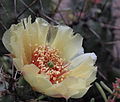Opuntia fragilis, known by the common names brittle pricklypear and little prickly pear, is a prickly pear cactus native to much of western North America.
Description
Opuntia fragilis is a small, prostrate plant, up to 20 centimetres (8 in) tall.[3] The joints are tumid, fragile, easily detached, oval, elliptical, or subglobose, 3–5 cm (1–2 in) long and nearly as thick as broad, bright green. The areoles are 0.6–1.3 cm (1⁄4–1⁄2 in) apart, with whitish wool and a few white to yellow bristles, which are much longer and more abundant on older joints. There are 2–7 spines up to 1–6.5 cm (1⁄2–2+1⁄2 in) long and 1–3 very short ones; they are dark brown[3] and weak, the upper spine usually longer and stronger than the others.
The flowers are greenish yellow, 2.5–3.2 cm (1–1+1⁄4 in) wide. The fruit is ovate to subglobose with few spines or bristles, mostly sterile, up to 2.5 cm (1 in) long, with many seeds.[3]
Subspecies and varieties
- Var. brachyarthra, Coult. A plant with more swollen joints, more numerous and stronger spines, smaller flowers and more spiny fruit Colorado, New Mexico.
- Var. caespitosa, Hort. Joints bright green, smaller and more crowded than in the type: flowers bright yellow. Colorado.
- Var. fragilis[4][5]
- Var. tuberiformis, Hort. Joints olive-green, bulbous-looking. Colorado.
Distribution and habitat
It is native to much of western North America as well as some midwestern states such as Illinois, Iowa, Wisconsin and Michigan. It also occurs in several Canadian provinces. It is known from farther north than any other cactus,[6] occurring at as far as 56°N latitude in British Columbia.[7] There is an isolated and possibly genetically unique population in Eastern Ontario known as the "Kaladar population".[8]
It grows on outcrops, dry grassy knolls, and in sandy soil, along with sagebrush and junipers.[3]
Gallery
-
Opuntia fragilis var. denudata
-
Opuntia fragilis var. denudata
-
A hybrid
References
- ^ Pinkava, D.J.; Puente, R.; Baker, M. (2017) [amended version of 2013 assessment]. "Opuntia fragilis". IUCN Red List of Threatened Species. 2017: e.T151913A121572262. doi:10.2305/IUCN.UK.2017-3.RLTS.T151913A121572262.en. Retrieved 16 September 2021.
- ^ NatureServe (2024). "Opuntia fragilis". Arlington, Virginia. Retrieved 6 January 2024.
- ^ a b c d Turner, Mark; Kuhlmann, Ellen (2014). Trees & Shrubs of the Pacific Northwest (1st ed.). Portland, OR: Timber Press. p. 422. ISBN 978-1-60469-263-1.
- ^ "Opuntia fragilis". Lady Bird Johnson Wildflower Center The University of Texas at Austin. 2016-03-04. Retrieved 2022-03-25.
- ^ "Opuntia fragilis". US Forest Service. Retrieved 2022-03-25.
- ^ Hogan, C. Michael (2011). Cactus. Topic ed. Arthur Dawson. Ed.-in-chief Cutler J.Cleveland. Encyclopedia of Earth. National Council for Science and the Environment. Washington DC
- ^ Gorelick, Root (2015). "Northern Range Limit of Opuntia fragilis and the Cactaceae is 56°N, Not 58°N". Madroño. 62 (2): 115–123. doi:10.3120/0024-9637-62.2.115. S2CID 85912474.
- ^ Mottiar, Yaseen; Chafe, Paul D.J.; Ribbens, Eric (2015). "Imperfect Flowers of Opuntia fragilis in Kaladar, Ontario". Haseltonia. 20: 22–25. doi:10.2985/026.020.0105. S2CID 84131774.




















You must be logged in to post a comment.